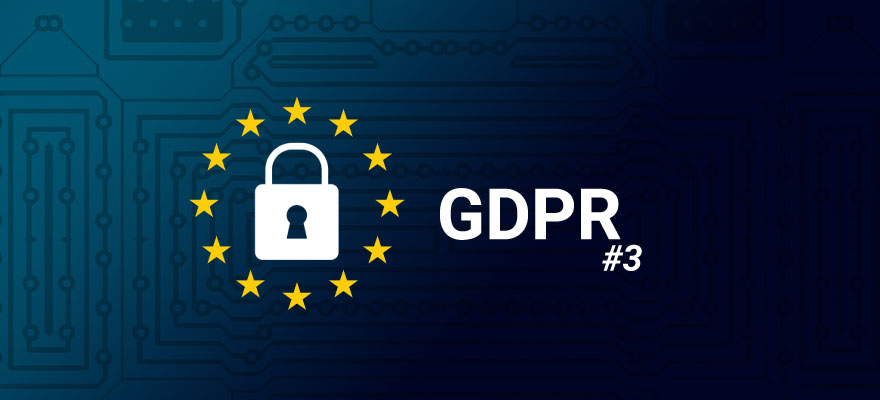In the first two articles, we explained what the GDPR really is through 5 Ws, what it implies for your business in a first time, and how to make your e-mail collection forms compliant. But have you thought about the existing email lists?
What give you a lot of ideas, information, but there is still plenty of work to do.
There remains one last crucial question that we have not addressed yet: what to do with your current lists. Especially if you have no consent record to show that your subscribers have given you their consent to receive your emails?
Indeed, the GDPR does not only apply to future subscribers that you will generate, but also to those already present in your list(s).
In other words, and to make it easier: how to requalify your already existing contact lists?
Even easier: what to do to continue sending emails to your contacts?
Does it interest you? That’s good we explain everything in our article of the day.
# 1: Write/edit your Privacy Policy
« We’re updating our Privacy Policy » …
Do these email lines tell you something? You must have already received dozens, but have you really paid attention?
Well, I’m not saying that the other stages are, but for once, it’s clearly the least funky! Still, this is probably the very first thing to do to be in compliance with the GDPR.
If you read our second article (available here), you know that you are now legally required to add a link to your Privacy Policy. This link must come in registration forms.
However, most companies generally have, at best, only one page of Legal Mentions.
This link should no longer redirect to a section of your “Legal Mentions”. It must take to a page dedicated to your Privacy Policy.
Important: If you work for a large company and you are in charge of issues related to the GDPR, we advise you to use a legal service for writing your privacy policy.
If you have already obtained the consent of subscribers to your email list, simply send a email updating your Privacy Policy, like the ones at the beginning of this post.
Otherwise you must send them requalification e-mails following the article.
# 2: What is a requalification campaign?
First, keep in mind that a requalification campaign is the method to update a contact list.
Before the GDPR, this method was primarily used by marketers to “clean” a list of contacts.
More simply, it allows to re-engage contacts from email lists who have not opened your emails for a while. Also, to “reclassify” them in a secondary list gathering your contacts categorized as inactive.
Why? Because separating inactive contacts from the rest of your list helps to maintain a certain level of efficiency in your email marketing campaigns.
As I told you, that was before the GDPR. With this new regulation, these requalification campaigns can also allow you to obtain, or rather to re-obtain the consent of your contacts, so as to be able to prove it in case of GDPR conformity control.
# 3: When to carry out a requalification campaign of your email lists?
There are three scenarios today that you may face:
Case scenario N° 1
The consent of your contacts has been collected in a clear, transparent and explicit manner via a form in due form, whether on your site, your blog, a landing page or an online advertising campaign (example: advertisements “Lead generation” of Facebook).
You are able to provide proof of these consents in case of control. Note that if your forms have been well designed at the base and you are using e-mail marketing software worthy of the name, you must be able to find on it the date of this consent (opt-in). in) in detail of each of your contacts.
In this case, you do not need to send a requalification campaign to the email lists. You can continue to send them your email marketing campaigns as you wish, provided of course not to lose track / proof of initial consent.
Case scenario n ° 2
As in the situation n ° 1, the consent of your contacts was collected in a clear, transparent and explicit way, etc.
On the other hand, and contrary to case 1, you do not have or more proof of this initial consent.
In this case, you must imperatively (in any case I strongly advise you) quickly send a requalification campaign to your contacts in order to re-obtain their consent in order to be able to prove it.
Case scenario n ° 3
The consent of your contacts has not been collected in a clear and explicit manner and you are unable to prove it.
Example: if you have proposed a free download guide on your site and your contacts have downloaded it without any clarification on your part as to their automatic registration to your newsletter (+ information on the forms of collection of email compliant with the GDPR by clicking HERE).
In this case, you must not (or again, I do not advise you) send a requalification campaign.
Indeed, the purpose of this type of campaign is here to requalify your contacts who have already given their explicit consent, even if you are not able to prove it.
It is not a question of getting the consent of your contacts here for the first time because the GDPR comes into effect.
In practice (yes we all know it), many companies are still heading to Case No. 3 for a variety of reasons, which may or may not make sense.
It is therefore up to you or your management to make this decision and risk or not be caught by a supervisory authority afterwards.
I am not here to judge, only to tell you what is consistent with the GDPR and what is less, if at all.
However, if your company processes a large amount of personal data, I advise you not to really play with fire, you will be warned.
# 4: How to lead/build a requalification campaign?
Before sending your requalification campaign (or re-consenting if you prefer), I advise you to prepare everything in advance and follow a few steps.
As a reminder, I advise you to follow these steps and to send your requalification campaigns only if you are in the case of figure n ° 2 described in point # 3 of this article.
1- Clean your contact list to erase the invalid email addresses
Well, as long as we are there, as you will surely lose contacts since not everyone will open your requalification email or emails, and even those who open this mail will not click. Necessarily to give you their consent (unless you have 100% open rates of your emailing campaigns, and in this case I am interested in all the tips you could give me), to begin to clean upstream.
In other words, clean your contact list to remove invalid email addresses.
For this, and even if it is not 100% effective, there are many tools, for example, among others:
- Email List Verify
- BriteVerify
- DataValidation
- Klemail
- CaptainVerify
2. Erase the completely inactive contacts from email lists
It’s up to you to decide how long a contact who no longer opens your emails can be considered inactive.
Personally, if a contact has not opened my emails for the last 6 or 12 months, I consider that he is no longer interested and I delete them from my lists.
Or at least, I kept them in secondary lists (cold list). But with the GDPR, without any malice, these contacts are no longer of any use.
Why not keep it?
Simply because the more contacts that do not open your emails, the more your campaigns fall in efficiency, but the more your deliverability rate drops!
Basically, the rate of deliverability is the rate (in %) of people who will actually receive your emails.
The more contacts you have that do not open your emails, the lower the rate, and the less your contacts will receive your emails (at the whim of your e-mail marketing tool and different email servers like Gmail, outlook, etc. which can in some cases completely blacklist your emails, no matter who they are).
Which means that even those of your contacts who really want to receive all your emails will not even receive them anymore.
That’s why it’s useless to keep them: not productive
3- Send a requalification campaign to the email lists
An advice: from the beginning, I am writing about requalification campaign. Which does not mean that this campaign should only contain one email. Depending on the size of your list (but also the result of the first email sent), I advise you to send a series of emails (three e-mails for example) to carry out your requalification campaign.
Of course, do not send the same email three times in a row, but prepare a three-email campaign by changing the content.
In addition, do not send a simple email asking for the consent of your contacts. Be a little pedagogue. Remind them why they receive your emails, highlight the quality of the content, then ask them if they still want to receive your content.






